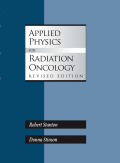
Applied Physics for Radiation Oncology, Revised Edition
Author: Robert Stanton and Donna StinsonISBN: 9781930524408
Published: 2009 | 292 pp. | Softcover
Price: $ 105.00
Health Physics | December 2010, Vol. 99, No. 6
Applied Physics for Radiation Oncology is a great introductory book for radiation therapists or dosimetrists interested in learning the basic physics involved in radiation therapy. Stanton and Stinson preface the book by appropriately distinguishing their audience as radiation therapists; however, its broad overview of therapeutic radiological physics could be a valuable reference for medical physics or health physics students. The 17-chapter book starts with a brief, four-page review of energy and matter before it touches on the properties of radiation. Without jumping into the physics, Stanton and Stinson methodically step through the basic structure of an atom, and relevant definitions to radiation and radioactivity. The text does not assume the reader has a physics background, yet it manages to clearly introduce the rudimentary physics necessary for radiation therapy.
Chapters 3-5 focus on the production and properties of x-rays, including basic photon interactions. The corresponding diagrams are straightforward and easy to understand, illustrating concepts such as ionization, attenuation, and step-by-step photon interaction processes. The authors are consistent in balancing the critical aspects of interest to a therapist while concomitantly providing the principles of physics. Chapter 6 emphasizes the fundamental types of radiation detection including gas ionization, scintillation, and solid-state detectors. The chapter depicts the operational basics such as available control knobs on survey meters and TLD readers for acquiring measurements. The following chapter complements the detection basics by introducing the significance of exposure, kerma, and the cavity theory and describing how these translate into dose. I imagine that a first-time user of such equipment would find this text extremely pragmatic and valuable in learning how to perform radiation measurements.
Generally speaking, the first seven chapters present a foundation for constructing the mechanisms by which physics is applied in radiation oncology. The subsequent five chapters concentrate on photon beams, addressing topics such as the energy of beams useful for treatment (Chapter 8), the production of high energy beams using linear accelerators (Chapter 9) and other devices (Chapter 10), the geometry of photon beams (Chapter 11), and special issues involved in photon beam dosimetry (Chapter 12). The authors provide a more comprehensive coverage of photon beam physics while centering on its application for external radiotherapy. A student transitioning into any role within radiation oncology would find new concepts in these chapters clearly defined, and well illustrated. There are 18 figures in Chapter 9 alone to support the description and function of the major linear accelerator components. The text details the path of an initial electron as it traverses the waveguide and bending magnets to the x-ray target, subsequent flattening filter, and collimation. Similarly, Chapter 11 resumes the photon path by characterizing the properties of photon beams and their resultant treatment fields by introducing beam collimation, simple arrangements, and depth dose profiles. Although the chapter is not intended to train the reader as a dosimetrist, it is a nice preface to learning about the standard photon beam dosimetry models used in radiation therapy. So, whether photon beams are a new concept or not, Chapter 12’s dosimetry terms are accessible to nearly any reader. By the end of this chapter, the reader should have a reasonable understanding of tissue-air-ratio’s and tissue-maximum-ratios for performing monitoring unit calculations.
The progression of the book is logical with each chapter building upon the stated objective of learning clinically applied physics. Chapter 13 touches on electron beams and associated dose calculations, which quickly moves to focus on radiation treatment planning. The book defines rudimentary concepts central to treatment planning such as positioning aides and isodose distributions, and also contains several examples of common treatment techniques. Chapter 15 elaborates on the application of treatment planning concepts such as mixed beams, tangents, and weighting for specific clinical treatments. The chapter also introduces more advanced methods such as 3D conformal, intensity modulation, image guidance, and gated radiotherapy. The appeal of this book for a health physicist is that it requires no therapeutic background in order to gain a general synopsis of the clinical approaches for treating cancer. The final two chapters primarily serve as a practical addendum on brachytherapy and radiation safety. Despite their brevity, the chapters consolidate the significant clinical terminology and safety aspects valuable to a therapist.
On the whole, Stanton and Stinson have managed to simplify several complex physics concepts such that nearly anyone could pick up this book and learn. I admire their ability to concisely convey the essential physics in a clear and approachable manner. Applied Physics for Radiation Oncology spans the gap between the numerous informational publications describing treatment to patients and the in-depth physics text intended for professional physicists.
Camille Lodwick
Oregon State University, Dept. of Nuclear Engineering and Radiation Health Physics
Corvallis, OR


